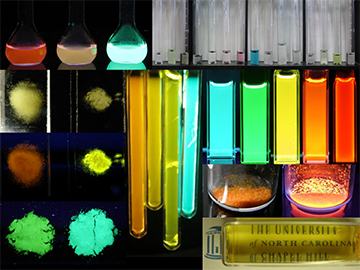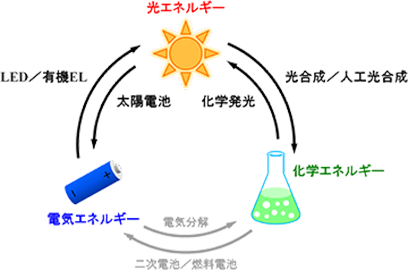Research
研究キーワード/Keywords
蛍光性有機化合物
Fluorescent Organic Compounds
りん光性金属錯体
Phosphorescent Metal Complexes
分子内電荷移動
Intramolecular Charge Transfer
励起状態ダイナミクス
Excited-State Dynamics
光誘起電子移動
Photoinduced Electron Transfer
励起エネルギー移動
Excited-State Energy Transfer
発光性材料
Luminescent Materials
人工光合成
Artificial Photosynthesis
研究概要/Research Outline
我々の身のまわりは色の付いている物質や光る物質で満ち溢れています。これらの性質はそれぞれ物質による可視光線の吸収・放出に由来します。また人工光合成(光 → 化学物質)や太陽電池(光 → 電気)に代表されるように、光エネルギーを異種エネルギーへと変換する(光-エネルギー変換)系の構築は非常に重要な研究課題になっています。本研究室では、分子やその複合体を基本とする様々な光吸収・発光物質を創出し、さらに周辺環境応答性や光励起(≒光吸収)をきっかけとする反応といった機能性を付与した系の構築とその理解を目指しています。
いずれのプロジェクトにおいても、設計、合成・調製、物性測定、解析・理解、設計へのフィードバックというサイクルを自らの手で行っていくことによって、より良い性質を示す材料・システムを構築します。
All around us, there are many materials which appear or glow with color by absorbing or emitting visible light. These properties originates from the visible-light absorption and emission by materials. In addition, the construction of systems which convert light energy into different types of energy (i.e., solar–energy conversion such as artificial photosynthesis and photovoltaics) has become an extremely important research topic. Our group aim to develop light-absorbing and -emitting materials based on molecular/supramolecular systems, and to construct and understand the photofunctional systems exhibiting responsiveness to the surrounding environment, reactions triggered by photoexcitation (≈ light absorption) and so forth.
In all the projects, we construct materials/systems with better properties through the cycle of design, synthesis/preparation, measurements, data analysis/understanding and feedback to the design.
1.光吸収/発光性色素材料
Light-Absorbing/Emitting Materials
可視光を吸収あるいは放出する物質は、塗料や電界発光(electroluminescence: EL)素子における色素として利用することができます。様々な骨格・構造・置換基を有する物質を系統的に合成し、その光吸収・発光の由来を明らかにすることで望みの機能をもつ色素材料とその設計指針を提供します。
Materials with visible-light absorption and/or emission are utilizable as dyes/pigments in paints, electroluminescence (EL) devices, etc. We provide materials with a desired function(s) and their design strategy by systematic synthesis of molecule-based systems with various skeletons, structures and substituents, follows by revealing the origin/nature of their light absorption and emission.
2.環境応答性化合物
Environment-Responsive Compounds
周辺の環境によって波長や強度などの光吸収/発光挙動が変化する物質は、高感度な分析だけでなく、目視での検出をも可能にします。共存する物質や溶媒、温度といった特定の環境に応答して光吸収/発光挙動が変化する化合物を緻密な設計をもとに合成し、その挙動の詳細を明らかにします。
Materials whose light absorption and/or emission behaviors are varied by the surrounding environment enable visual detection as well as sensitive analysis. On the basis of precise design, we synthesize sensing compounds for specific environments (e.g., coexisting species, solvents, temperature, etc.), and reveal their behavior in detail.
3.高効率な光誘起反応システム
Efficient Photoinduced-Reaction Systems
光吸収によって生成する励起状態は非常に高エネルギーであるため、大きな反応駆動力をもっているほか、熱反応とは異なる反応・生成物を与えることもあります。しかしながら、励起状態は極めて短寿命であるため、物質間の反応を効率よく起こすためには非常に高い濃度の反応物を必要とします。少量の反応物でも高効率な光誘起反応を起こす系を簡便な手法により構築し、その挙動を解明することによって光-エネルギー変換システムとして展開します。
Owing to its high-energy nature, excited states generated by light absorption possess a large driving force for the reactions and often afford different reactions and products from thermal reactions. However, highly-concentrated reactants are typically required to obtain efficient reactions owing to short-lived characteristics of the excited states. We construct efficient photoinduced-reaction systems even with small amount of reactants by a simple method, and elucidate the behaviors aiming at an utilization in solar–energy conversion systems.







